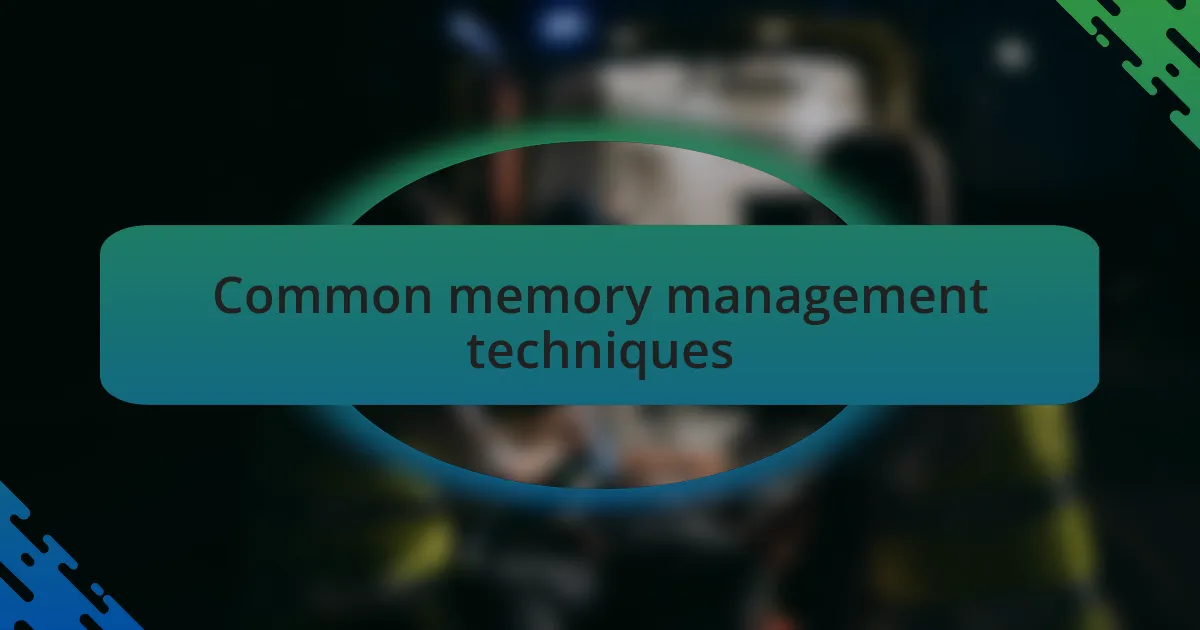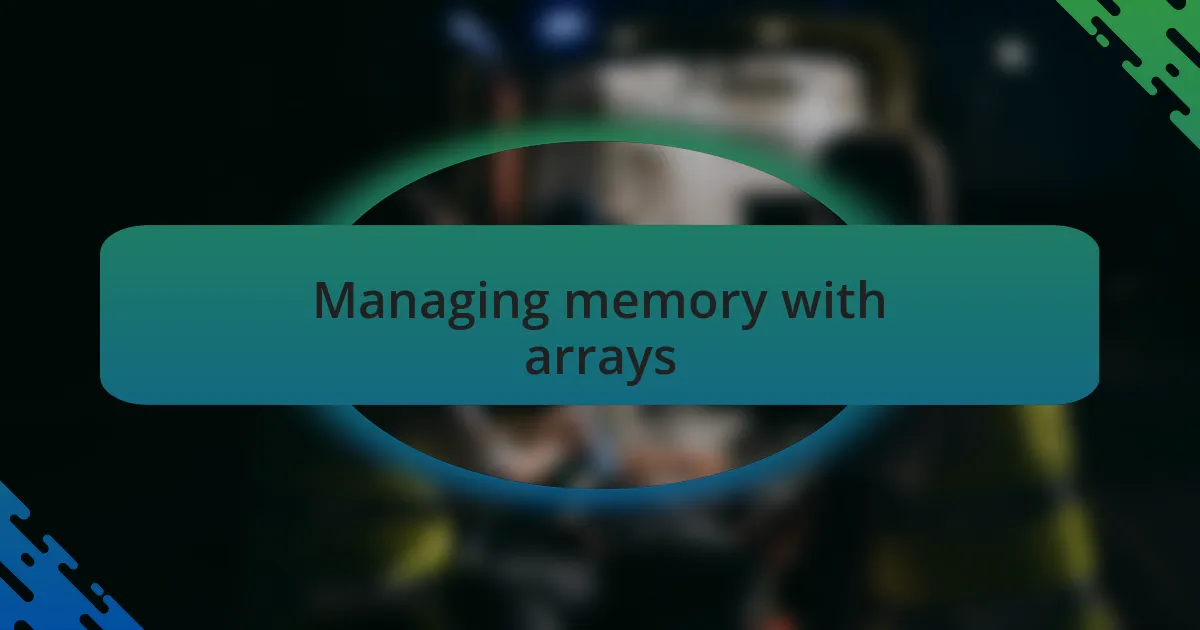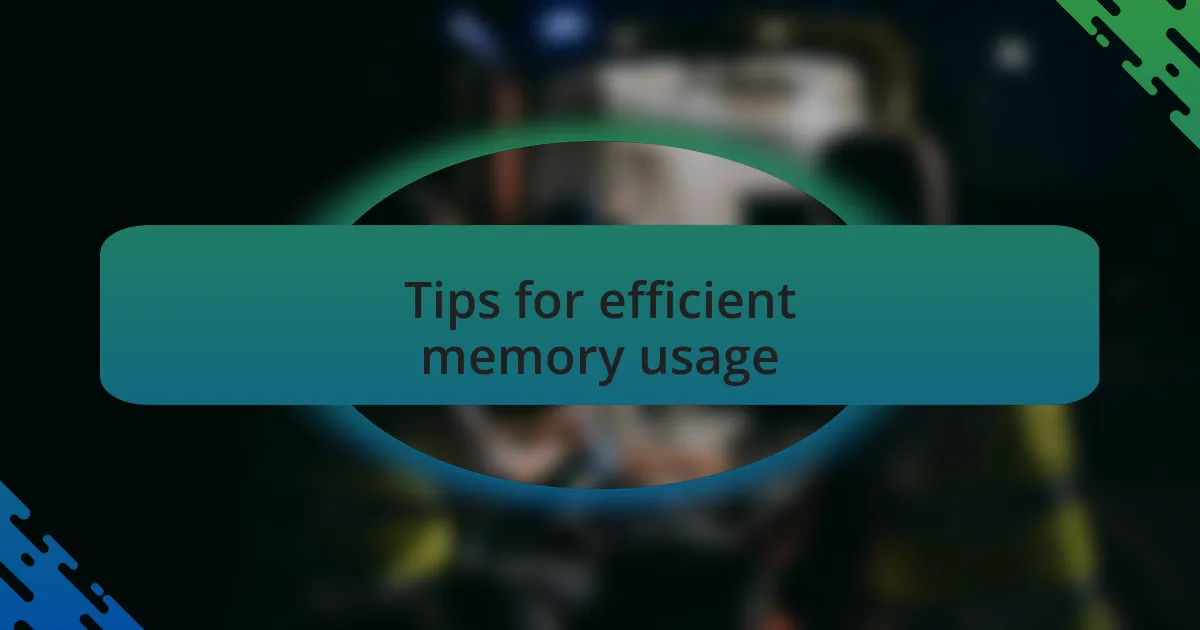Key takeaways:
- Understanding the difference between stack and heap memory is crucial for effective memory management in C++, as heap memory requires careful tracking to avoid leaks.
- Smart pointers, such as std::unique_ptr and std::shared_ptr, automate memory management and mitigate common pitfalls like memory leaks and circular references.
- Efficient memory usage can be enhanced by pre-allocating memory, using local variables over global ones, and ensuring proper alignment in data structures.

Understanding memory management in C++
Memory management in C++ is fundamentally important because it directly influences the performance and reliability of applications. Speaking from experience, I remember struggling to grasp the intricacies of dynamic memory allocation when I first started coding. I often asked myself, “Why does this seemingly effortless task cause so many headaches?” The reality is that C++ gives you direct control over memory with features like new and delete, which, when wielded wisely, can optimize resource use but require careful handling to avoid leaks.
One aspect that often perplexes new developers is the difference between stack and heap memory. The stack is where local variables reside, automatically handled for you, while the heap is where things become more complex. I’ve learned that allocating memory on the heap gives flexibility but also introduces the risk of memory leaks if not managed properly. Have you ever noticed your program slowing down or crashing unexpectedly? Often, it’s a sign of poor memory management practices, reminding me of the importance of diligent tracking.
Additionally, C++ also offers smart pointers as a modern solution to handle memory more safely. Early on, I often forgot to free memory, which led to frustrating debugging sessions. Using smart pointers such as std::unique_ptr or std::shared_ptr has transformed my approach, providing peace of mind that resources will be released when no longer needed. Isn’t it a relief to know that the language has tools to help mitigate such common pitfalls?

Common memory management techniques
Mastering common memory management techniques can make a significant difference in your C programming experience. One technique I often use is manual memory allocation with the malloc and free functions. Initially, these functions seemed daunting to me, but as I practiced, I appreciated their power. They allow for dynamic memory allocation, which means you can just request the amount of memory you need at runtime, rather than at compile time. Have you ever felt the frustration of an array being too small? This technique can solve that issue.
Then there’s the concept of memory pooling, which I didn’t grasp until I encountered performance bottlenecks. By allocating a large block of memory upfront and managing small allocations within that block, I found my programs ran much faster. It’s like having a personal storage unit instead of scattering boxes throughout your house. This method reduces fragmentation and improves allocation speed, something that truly resonates with me after countless hours of optimizing performance.
Lastly, I’ve come to appreciate the use of reference counting in managing dynamic memory. Implementing my own reference counting system made me realize how easy it is to lose track of allocated objects. It’s a simple way to keep tabs on how many parts of the program are using a piece of memory, allowing for automatic deallocation when it’s no longer in use. Have you ever had the helpless feeling of a memory leak creeping up on you? Using this technique was a game changer—and with it, I felt like I’d finally tamed the wild beast of memory management.

Smart pointers in C++
Smart pointers in C++ offer a powerful alternative to traditional memory management methods. I recall the moment when I first encountered std::unique_ptr; it felt like a breath of fresh air in my coding practice. Unlike raw pointers, unique_ptr ensures that memory is automatically deallocated when it goes out of scope, eliminating the nagging worry of memory leaks—something that haunted me during those earlier development days.
Then there’s std::shared_ptr, which I found indispensable when dealing with shared ownership of resources. I remember struggling with the idea of how multiple parts of a program could safely access a single piece of memory without the risk of one component deleting it while another was still using it. By implementing shared_ptr, I discovered the magic of reference counting at play, and I felt an immediate relief knowing that the memory would persist as long as it was needed. How reassuring is that—knowing that your resources are handled intelligently?
Lastly, it’s important to mention std::weak_ptr, which helps to break circular references, a trap I’ve unfortunately fallen into before. I vividly recall debugging a memory leak that arose from two shared_ptrs pointing to each other, leading to a standstill. When I learned to use weak_ptr, it felt like I had a guiding light to navigate out of a dark labyrinth. Each smart pointer serves a specific purpose, and integrating them into my workflow has certainly made memory management a smoother journey.

Managing memory with arrays
Managing memory with arrays requires a nuanced understanding of how memory allocation works in C. I remember my first experience with arrays; it was exhilarating and terrifying at the same time. I had to allocate memory manually using malloc, and I vividly recall my anxiety when I had to remember to free it later. That moment of forgetting to call free wasn’t just a minor oversight, as it led to a memory leak that marred my otherwise clean project.
When I started experimenting with dynamic arrays, I learned the importance of resizing them using realloc. Initially, I struggled with thinking about what would happen if the current memory block couldn’t accommodate the new size. I often found myself thinking, “What happens to my data during this process?” It was eye-opening to realize that realloc not only moves data but also has the potential for failure, requiring me to check if the operation succeeded. Developing this cautious approach made me appreciate the intricacies of memory management more profoundly.
Handling multi-dimensional arrays was another leap for me. I still remember the confusion of calculating indices when using pointer arithmetic. It felt like a puzzle that I had to solve each time. If I had a 2D array, how could I efficiently access elements without losing track of my calculations? I started noticing how essential it was to keep my mental map clear, as even a small error could lead to segmentation faults. It taught me a valuable lesson: with great power comes great responsibility, especially in C programming.

Tips for efficient memory usage
When it comes to efficient memory usage in C, I always emphasize the importance of pre-allocating memory when possible. I recall a time when I was working on a project involving large datasets, and instead of growing my array dynamically with each insertion, I sized it based on an estimated maximum. It not only improved performance but also reduced the complexity of my code. Have you ever faced the frustration of frequent reallocations disrupting your flow? Trust me, planning ahead can significantly streamline your memory management.
Another aspect I consider crucial is the practice of using local variables instead of global ones whenever applicable. I distinctly remember a debugging session where global variables caused unexpected behavior in my programs. The moment I switched to local variables, everything fell into place, and my code became easier to understand and maintain. Why make your program’s behavior harder to track when you can keep things localized? Keeping your variables confined can lead to fewer bugs and a clearer understanding of how data flows within your program.
Lastly, I can’t stress enough the value of proper alignment in structures. In my early days, I faced performance issues due to misaligned data and inefficient memory accesses. By aligning data structures according to their types, I noticed a tangible boost in my application’s efficiency. It made me wonder why I hadn’t focused on this aspect sooner. Understanding how alignment plays a role can make all the difference in making your applications not only faster but also more memory-efficient.